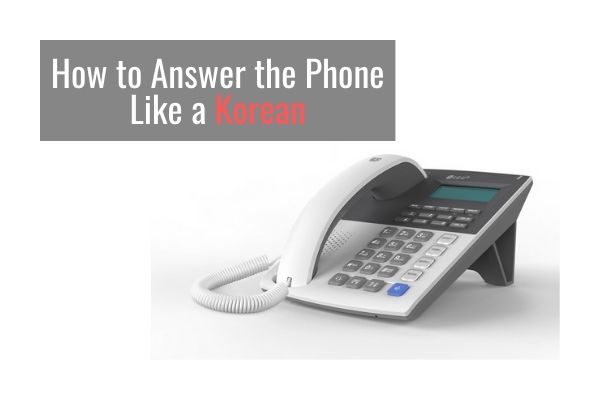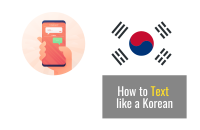Answering the phone in Korean can be intimidating.
There are a few rules about phone etiquette that you should know.
Like with most business-related things in Korea, answering the phone requires a certain amount of protocol.

Quick Summary
- “Yeoboseyo (여보세요)” is a casual way to say hello on the phone in Korean.
- Each Korean company has a different script but “Kamsahamnida. [company name, your team, your name] imnida. (감사합니다. __입니다.)” is a professional way to answer the phone.
Not answering the phone correctly will make you look unprofessional, and you might have to hear your boss complain.
Useful Vocabulary
- Phone – 전화
- Cell phone – 휴대폰, 핸드폰
- Smartphone – 스마트폰
- Answer the phone – 전화를 받다
- Hang up the phone – 전화를 끊다
- To have the wrong number – 전화를 잘못 걸다
- vibrate mode – 진동 모드
- silent mode – 무음 모드
- ringer on – 벨소리 모드
- Button – 버튼
- Delete – 삭제
- Video call – 영상 통화, 영통 (abbreviation used by young Koreans)
- To have a video call – 영상 통화하다
- Message – 메세지
- Text message – 문자
- Send a text message – 문자 보내기
- Leave a message – 메세지 남기기 (Koreans don’t leave voice messages at all. It just feels strange to us. Koreans will just hang up if you don’t answer the phone. When Koreans see a missed call, they either call back or send a text or KakaoTalk message.)
Useful Phrases
Hello – 여보세요 (casual) 감사합니다 (formal)
I will call again later. – 이따가 다시 전화할게. (casual) 나중에 다시 전화드리겠습니다. (formal)
Would you like to leave a message? – 메모 남겨드릴까요?
Who is this, please? – 누구세요? (casual) 누구신지 여쭤봐도 될까요? (formal)
I cannot hear you clearly. – 잘 안들려. (casual) 연결 상태가 안좋아서 잘 들리지 않습니다. (formal)
Sorry, wrong number. – 죄송합니다. 전화 잘못 거셨습니다.
The line is disconnected. – 전화가 끊겼습니다.

Step 0
While working at Korean companies, I was always told to pick up the phone before it rings 3 times.
If you answer the phone after that, start the conversation by saying “기다려주셔서 감사합니다”.
Step 1
When answering the office phone in Korea, it’s a good idea to start by thanking the caller.
“감사합니다.”
(Saying “여보세요” will sound very unprofessional at the office.)
Step 2
It’s important to state your company name followed by your name then -입니다(-ibnida).
“Company Name, (Your Team), Your Name입니다.”
Step 3
If the person is trying to reach you, tell them to go ahead and speak.
“네, 말씀해주세요.”
Step 4
If the person is trying to reach someone else, say that you are transferring them before doing so.
“연결해드리겠습니다. 잠시만 기다려주세요.”
Step 5
If the person the caller is trying to reach is not available, say that he/she is absent at the moment and ask if they want to leave a message.
“지금 부재중입니다. 메모 남겨드릴까요?”
Step 6
When you are done, hang up the phone by saying thank you again.
“감사합니다.”
Insider Tip
If you answer the phone at work, it’s best not to hang up first.
If the other person on the phone is older or higher than you, it’s definitely better not to hang up first.
Koreans usually text in their personal lives.
Phone plans in Korea can be expensive, and people focus more on data than minutes.
This might be because Koreans prefer to text.
During casual phone calls, 어 (uh) 네 (neh), which mean yes in Korean, might be the only thing one says while listening to someone talk.
But, Koreans prefer to call when they need something done. It makes their request less likely to be ignored.
Answering the phone at your company is very different from answering a personal phone call.
Did we miss anything?
By following these simple rules, you can sound like a pro when answering the phone in Korean.
I spent the first week at my first job out of University learning phone etiquette among other things.
It was a bit stressful because my boss would listen in on my calls and critique me immediately after. This made me prefer writing emails.
Don’t worry if you make a mistake. Even some Koreans can’t follow this protocol.
Let us know if you have more questions in the comments.

